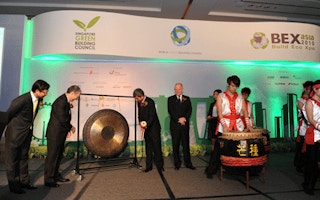The inability of Governments to reach a binding agreement on emissions targets at last year’s climate change talks has delivered the building industry with the perfect platform to assume leadership in reducing emissions, said the World Green Building Council (WGBC) chairman Tony Arnel on Monday.
Speaking at the opening of the WGBC Congress held in Singpaore this week, Mr Arnel said the building sector will be the key catalyst for change, especially in the Asia Pacific - the world’s fastest growing region.
China alone is constructing 2 billion square metres of new buildings each year, and between 2000 and 2030, it is expected to add twice the amount of office space that the US currently has. By 2050, 73 per cent of the country’s population is expected to line in cities, compared to 45 per cent today.
Leadership in this region “will be critical to ensure that the rapid expansion of the built environment in Asia has a minimal long-term environmental impact”, Mr Arnel told a 500-strong audience at the congress, hosted by the Singapore Green Building Council (SGBC) at the Marina Bay Sands Expo and Convention Centre.
Data from the Intergovernment Panel on Climate Change reveal that aggressive implementation of current technology and practices could reduce building related emissions by between 40 and 70 per cent, which is far more than originally predicted, said Mr Arnel. “We can only achieve this through international agreement and collaboration.”
The green building movement worldwide is gaining momentum, going by the increasing numbers of the WGBC members. Its numbers has more than doubled from 32 country members in 2008 to 76 in 2010.
These individual councils, are catalyst for their countries in the building sector, and can drive transformation, added Mr Arnel. Up for discussion at the congress is also the Green Building Sectoral Agreement, which aims to establish a clear and compelling case and framework for tackling greenhouse gas emissions for the building sector.
“To be effective we need the support of industry, followed by governments and other stakeholders. Sectoral Agreements can be powerful vehicles for policymakers to focus on critical sectors where greenhouse gas emission trends can be forecast, policies implemented effectively and the benefits of capacity building are clear.”
Mr Arnel highlighted Singapore as “leading the way in South East Asia”. Its construction sector accounts for more than $20 billion worth of contracts each year, and the country has a vibrant building sector. There is a target to green 80 per cent of all buildings by 2030, with a $300 million fund set aside to achieve this.
With the rise of the green building movement, there will also be demand for green building professionals to support the greening of the built environment, said Singapore’s Minister for the Environment and Water Resources Yaacob Ibrahim on Monday.
He estimates that Singapore would need to train about 18,000 to 20,000 green collar professionals over the next 10 years in the development, design, construction, operation and maintenance of green buildings.
The Singapore Green Building Council (SGBC), which became an established member of the WGBC this year, also launched its Green Building Product Certification Scheme on Tuesday at its first anniversary dinner.
SGBC president Lee Chuan Seng said that scheme adopts various assessment standards such as energy, water and resource efficiency, together with a life cycle approach to assess the level of environmental friendliness of building products.
It will provide the industry with products that have been “robustly assessed” and are fully integrated with the Green Mark Scheme.

















